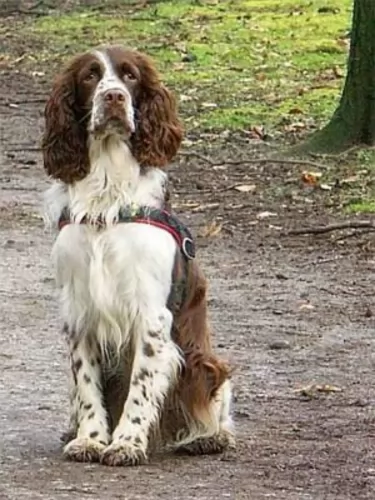 MyDogBreeds
MyDogBreedsBoth Russian Spaniel and Moscow Guard dog are originated from Russia. Russian Spaniel may grow 23 cm / 9 inches shorter than Moscow Guard dog. Russian Spaniel may weigh 52 kg / 114 pounds lesser than Moscow Guard dog. Russian Spaniel may live 3 years more than Moscow Guard dog. Both Russian Spaniel and Moscow Guard dog has almost same litter size. Both Russian Spaniel and Moscow Guard dog requires Moderate maintenance.
 The Russian Spaniel is a gun dog which has originated from the English Cocker Spaniel and the English Springer Spaniel. Today while he is a gun dog he is more of a companion dog.
The Russian Spaniel is a gun dog which has originated from the English Cocker Spaniel and the English Springer Spaniel. Today while he is a gun dog he is more of a companion dog.
The Russian Spaniel has been spoken about since 1891. Different Spaniel breeds were imported to Russia to be used for hunting but some of the smaller spaniels weren't suited to the weather conditions.
At the beginning of the 20th century, breeding programs got underway for longer legged spaniels, and by the late 1930's there were a variety of different spaniels in Moscow.
After World War II, more purposeful breeding got underway and this led to the the Russian Spaniel standard in 1951. The popularity of the dog has increased and in 2002 the Russian Spaniel Club was set up in the United States. The dog isn’t recognised by any major kennel clubs.
Looking much like the Saint Bernard, the Moscow Guard Dog or Moscow Watchdog is large, descending from quite a few giant breeds such as the Saint Bernard, different Russian Hounds and the Caucasian Ovtcharka.
The dog has a gentle temperament. Known also as a gentle giant, the Moscow Guard Dog was developed in the Soviet Union and is fairly common in its native country.
The first US-born litter of Moscow Guard Dogs was born in 2015. The Moscow Watchdog hasn’t yet been recognized by the AKC.
 The attractive little Russian Spaniel stands at 38 – 45cm in height ad weighs between 9 and 16kg. He is such a sturdy little dog too, looking very similar to the English Cocker Spaniel.
The attractive little Russian Spaniel stands at 38 – 45cm in height ad weighs between 9 and 16kg. He is such a sturdy little dog too, looking very similar to the English Cocker Spaniel.
The coat is short and silky with quite a bit of feathering around the legs and ears. Colors of the coat can be anything from reddish brown and white with freckles to black and white with freckles.
Aside from the Russian Spaniels' hunting abilities, they make great family pets and are playful with children.They’re devoted to their human families and become particularly attached to one person in the family.
Such devotion leads them to being a bit cool around strangers, not liking anyone unfamiliar to get too close to any of his family members.
He is intelligent and can be easily trained to obey simple commands such as sit, stay, lie down and come.
The Russian Spaniel can be happy in the suburbs, on a farm or in the city so long as he gets lots of attention and enough exercise.
The Moscow Watchdog is a large mastiff-type dog. He stands at between 64 and 69cm in height ad weighs in the region of 45 – 68kg. He has a thick coat which is medium length, he has floppy ears and a long, plumed tail. The most common colors for the Moscow Watchdog are red and white with a little bit of black and tan around the head.
He is quite a heavy shedder so regular brushing and grooming is recommended.
He takes his role seriously as guardian and protector of his human family.
Large dogs don’t usually live as long as smaller breeds, and with good care your Moscow Watchdog can reach between 9 and 11 years of age. If you want your dog to be a parent, the litter size you can expect is anything from 5 to 10 puppies.
The dogs were used for guarding purposes and they are strong-willed, dominant and independent. They are also gentle dogs but will still require training and socialization to make them obedient and an all-round pleasant dog.
While the Moscow Watchdog is described as a pleasant dog, he isn’t a friendly teddy-bear kind of dog, tending to be fairly aloof. He would do well with an owner who is firm, fair, consistent and strong, as he is strong-willed.
 The Russian Spaniel is such an energetic, dog, full of life ad with the joys of being alive.
The Russian Spaniel is such an energetic, dog, full of life ad with the joys of being alive.
Although he was a gun dog, today he is loved for his companionship. He makes a splendid family pet and loves to be involved with the games of children.
He is easy-going and social, and just wants to spend as much time as he can with his human family. Give him all the love you have and you'll see his tail never stops wagging.
The Moscow Watchdog is a large dog and beautiful to look at. Even though he is large and strong, he is gentle and calm and makes a splendid pet.
Because of his large size he is better suited to life in the countryside or the suburbs as compared to smaller properties in the city. Their exercise needs will also need to be met such as a walk every day.
Think carefully before you take such a large dog into your home as he will require a lot of good food. Before investing in any dog, make sure that you have the means to provide him with an excellent home where he gets the best care, because he is willing to give you the very best of himself.
 With very few health problems, the feisty Russian Spaniel can get to 12-14 years of age. Nonetheless, there are always some of the more common health issues to look out for.
With very few health problems, the feisty Russian Spaniel can get to 12-14 years of age. Nonetheless, there are always some of the more common health issues to look out for.
Russian Spaniels are prone to developing ear infections. Ear infections can be terribly frustrating for a dog and they are quite difficult to clear up. It is advised that dog owners use ear cleaners before infection sets in. The vet can advise you on this as you have to be careful not to damage the inside of the ear.
Itchy skin can be another terrible frustration for a dog. Allergies often cause terrible itching, and your dog will go mad trying to gnaw and bite at the itch. Finding the specific cause of a skin allergy can be very challenging. Blood tests might be required. It is imperative to feed your dog some raw meat occasionally to avoid these terrible skin infections.
The Moscow Watchdog is a healthy dog breed, and with few inheritable health problems, you’re not likely to spend much at the vet with him.
Of course, any dog needs a good diet, adequate exercise, vaccinations, and parasite treatments to stay in top condition. Some of the common diseases to look out for -
We always have to mention hip dysplasia as it is so common with all dogs. Its an hereditary condition where lack of hip joint stability causes pain inflammation and lameness in the dog. Your dog, even though he is young, can develop hip dysplasia and then it can lead to early arthritis too. Your dog will need to get to the vet.
 This dog was raised to be a gun dog, and is used to having plenty of exercise. Most imperative for him will be a couple of walks each day plus lots of chase-the-ball games. These dogs just never seem to get tired as they are playful and will never let the chance of a game pass them by.
This dog was raised to be a gun dog, and is used to having plenty of exercise. Most imperative for him will be a couple of walks each day plus lots of chase-the-ball games. These dogs just never seem to get tired as they are playful and will never let the chance of a game pass them by.
Spaniel ears require quite a bit of upkeep as the hair can become extremely matted, forming balls of knotted hair. The inside of the ears must be constantly checked for infection. The spaniel’s coat will need to be brushed regularly and he can even go to the groomers and get a short Spaniel cut.
Contribute to your pet’s good health by providing him with top notch food. A good nutritious diet for the Russian Spaniel will give your dog less of a chance to get sick. Always go for the best quality commercially manufactured dog foods.
To provide your dog with just a bit of variety in his diet, some home-made food added into the dry kibble from time to time will delight your pet. No need to make preparing the food a huge issue either. Boil brown rice and chicken in a pot and add in sweet potatoes, carrots and spinach. Chop all this up, and as a treat, add smaller portions of it into the dry kibble.To avoid skin infections, try to include some raw meat into his diet occasionally.
Never leave your pet without a constant source of fresh, cool water
This is a large breed dog so you want to make sure that if you feed him from the many commercially manufactured foods there are, it is the high quality one packed with vitamins and minerals and which cater specifically for large breeds to ensure the right amount of minerals and vitamins for his size.
You don’t want to just go on and on giving him dry kibble every day, so occasionally it will be a good idea to give him some boiled chicken, brown rice or pasta and some cooked vegetables which can be added into his kibble. This is all the variety your dog needs, as dogs like consistency and simplicity because then they don’t suffer with digestive issues.
Never leave him without a constant source of cool, fresh water.
Contrary to what this dog looks like – large and clumsy, he is actually quite agile and will require a good amount of exercise. He may not look particularly active but he will certainly want a daily walk and he will also require running off the leash in the park or some ball and rope games in the garden.
he Moscow Watchdog has a thick, medium length coat. He doesn’t require professional grooming, but a good brush through once a week will help to condition the coat. Also, the breed is a moderate shedder so removing loose hair keeps the coat shiny and healthy.